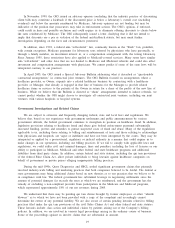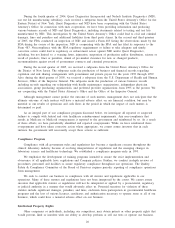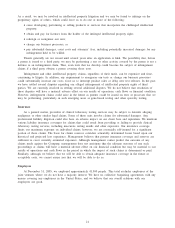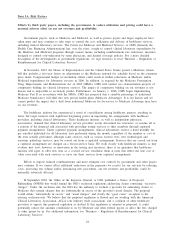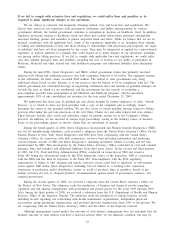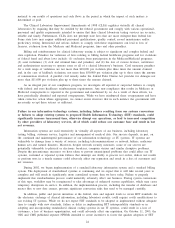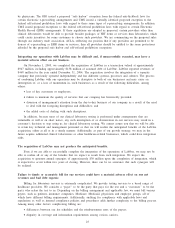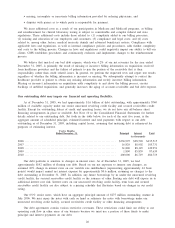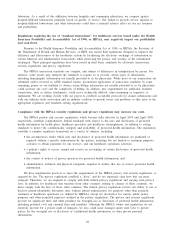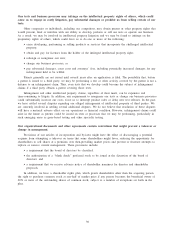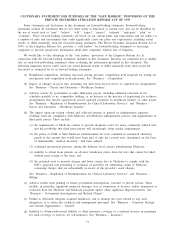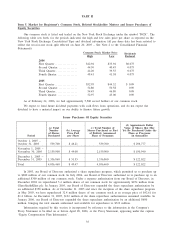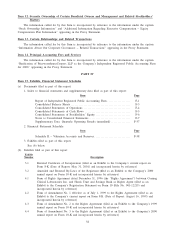Quest Diagnostics 2005 Annual Report Download - page 46
Download and view the complete annual report
Please find page 46 of the 2005 Quest Diagnostics annual report below. You can navigate through the pages in the report by either clicking on the pages listed below, or by using the keyword search tool below to find specific information within the annual report.Compliance with all of the HIPAA regulations, including new standard transactions, requires ongoing
resources from all healthcare organizations, not just Quest Diagnostics. While we believe our total costs to
comply with HIPAA will not be material to our operations or cash flows, new standard transactions and
additional customer requirements resulting from different interpretations of the current regulations could impose
additional costs on us.
FDA regulation of laboratory-developed tests, analyte specific reagents, or genetic testing could lead to
increased costs and delays in introducing new genetic tests.
The FDA has regulatory responsibility over instruments, test kits, reagents and other devices used to
perform diagnostic testing by clinical laboratories. In the past, the FDA has claimed regulatory authority over
laboratory-developed tests, but has exercised enforcement discretion in not regulating tests performed by high
complexity CLIA-certified laboratories. In December 2000, the HHS Secretary’s Advisory Committee on Genetic
Testing recommended that the FDA be the lead federal agency to regulate genetic testing. In late 2002, a new
HHS Secretary’s Advisory Committee on Genetics, Health and Society, or SACGHS, was appointed to replace
the prior Advisory Committee. Ultimately, SACGHS decided that it would continue to monitor the progress of
the federal agencies in the oversight of genetic technologies, but it did not believe that further action was
warranted. In the meantime, the FDA is considering revising its regulations on analyte specific reagents, which
are used in laboratory-developed tests, including laboratory-developed genetic testing. Representatives of clinical
laboratories (including Quest Diagnostics) and the American Clinical Laboratory Association (our industry trade
association) have met with representatives of the FDA to address industry issues pertaining to potential FDA
regulation of genetic testing in general and issues with regard to increased oversight over the analyte specific
reagents used in laboratory-developed tests in particular. We expect those discussions to continue. FDA interest
in or actual regulation of laboratory-developed tests or increased regulation of the various medical devices used
in laboratory-developed testing could lead to periodic inquiry letters from the FDA and increased costs and
delays in introducing new tests, including genetic tests.
The development of new, more cost-effective tests that can be performed by physicians in their offices or
by patients could negatively impact our testing volume and net revenues.
The diagnostics testing industry is faced with changing technology and new product introductions.
Advances in technology may lead to the development of more cost-effective tests that can be performed outside
of an independent clinical laboratory such as (1) point-of-care tests that can be performed by physicians in their
offices, (2) esoteric tests that can be performed by hospitals in their own laboratories or (3) home testing that
can be performed by patients in their homes or by physicians in their offices. Development of such technology
and its use by our customers would reduce the demand for our laboratory-based testing services and negatively
impact our net revenues. Currently, most of our clinical laboratory testing is categorized as “high’’ or
“moderate’’ complexity, and thereby subject to extensive and costly regulation, under CLIA. Manufacturers of
laboratory equipment and test kits could seek to increase their sales by marketing point of care laboratory
equipment to physicians and by selling test kits approved for home use to both physicians and patients.
Diagnostic tests approved or cleared by the FDA for over the counter (OTC) or prescription home use are
automatically deemed to be “waived’’ tests under CLIA and may be performed in physician office laboratories
with minimal regulatory oversight as well as by patients in their homes. The FDA has regulatory responsibility
over instruments, test kits, reagents and other devices used by clinical laboratories and the Secretary of HHS
has delegated to the FDA the authority to determine whether particular tests (waived tests) are “simple’’ and
have “an insignificant risk of an erroneous result’’ under CLIA. Increased approval of OTC or home test kits
and/or increased numbers and types of waived tests could lead to increased testing by physicians in their
offices, which could affect our market for laboratory testing services and negatively impact our net revenues.
Our operations may be adversely impacted by the effects of natural disasters such as hurricanes and
earthquakes, or acts of terrorism and other criminal activities.
Our operations may be adversely impacted by the effects of natural disasters such as hurricanes and
earthquakes, or acts of terrorism or other criminal activities. Such events may result in a temporary decline in
the number of patients who seek laboratory testing services. In addition, such events may temporarily interrupt
our ability to transport specimens or to receive materials from our suppliers.
29


